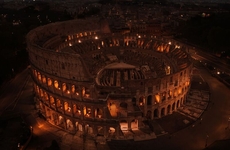
The Colosseum's Redesign will Feature Retractable Floors
Josh Thompson-Persaud — May 18, 2021 — Art & Design
The Colosseum, a popular tourist attraction in Rome, Italy, will receive a non-invasive modern redesign to add remote-controlled retractable floors to the arena. The new flooring project, developed by Labics, Fabio Fumagalli, and Milan Ingegneria, will make the arena walkable for tourists while allowing the floor to open to reveal the hypogeum–the complex underbelly of the arena that used to harbor lift systems and preparation chambers. In addition, the retractable floor will allow live performances to take place on the arena floor, further increasing the site's tourist traffic.
The retractable floor, which will be set on tracks over the Colosseum's existing foundations, will be made up of carbon-fiber slats with an Accoya wood finish. The light-colored finish is designed to increase the amount of natural light in the historical site. The retractable floor redesign will be finished by 2023.
Image Credit: Dezeen
The retractable floor, which will be set on tracks over the Colosseum's existing foundations, will be made up of carbon-fiber slats with an Accoya wood finish. The light-colored finish is designed to increase the amount of natural light in the historical site. The retractable floor redesign will be finished by 2023.
Image Credit: Dezeen
Trend Themes
1. Historical Site Modernization - The integration of modern tech such as remote-controlled retractable floors can give a historical site like the Colosseum new life and continue to drive tourism.
2. Non-invasive Redesign - The use of non-invasive redesign techniques can be applied to other delicate historical locations to preserve them while also modernizing them for tourists.
3. Multi-purpose Use - Integrating modern features into historical sites that allow for multi-purpose use could increase tourism and revenue while preserving the site's historical significance.
Industry Implications
1. Tourism - Tourism companies can look to modernize historical sites in a non-invasive way that preserves their visual and historical significance while increasing traffic.
2. Construction - Developers and construction companies can explore the use of non-invasive redesign techniques and modern tech features to upgrade historical sites to meet modern standards.
3. Entertainment - Integrating features such as retractable floors can open up historical sites to more entertainment opportunities and events, providing new revenue streams and increased tourism.
2
Score
Popularity
Activity
Freshness















